
Landing at Whangerei International Airport news awaited that the long spell of pleasant New Zealand weather had finally broken down and strong gale to storm force winds with heavy rain were forecast, exactly what we had asked Circa Marine to arrange. As you can see from the lead photo, these new seas, onshore in angle and so reflected back, were steep and confused. A perfect day for testing. Note: at the end of this blog is a short video.
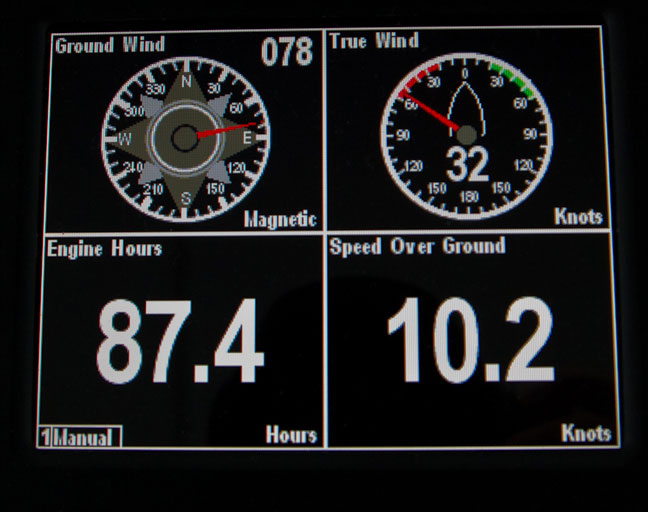
We moded the boat in a variety of speed, angle, and stabilizer situations. Heading into the seas, at 1800 to 1900 RPM we were averaging about 10 10.5 knots as the breeze gradually built to the low 30s, gusting as high as 39 knots.
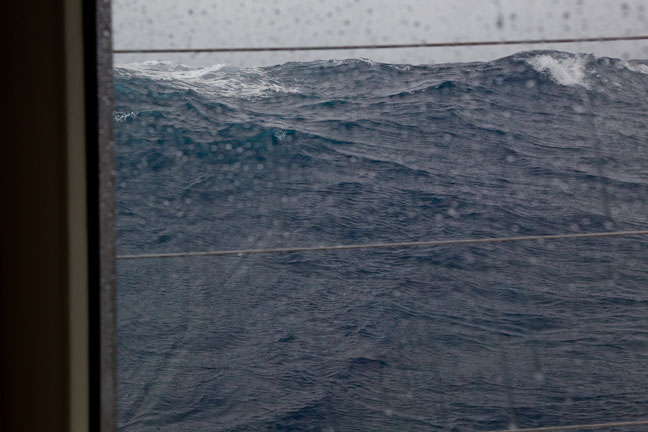
The sea above and the one below will give some sense of the conditions. These are 10’/3m or larger waves, with crests less than a boat length apart.
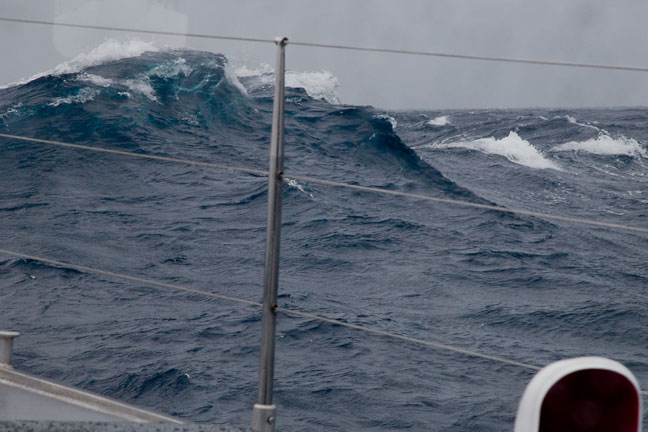
These are difficult conditions, as you can see. They provided a wonderful opportunity to observe motion and maneuverability, and set up various scenarios:
- Upwind at speeds down to three knots, directly into the seas and at 15/25 degrees off the bow. In these adverse conditons the FPB64 would comfortably jog in place even at the slowest speed. 1800 RPM, 10 knots, provided a good balance btween motion and speed of advance. We tested the equivelent of heaving to with sails, and found she would lie quietly, head to wind, at 1000 RPM doing 2.5 to 3.5 knots.
- Hove to like this in storm conditions response to the helm is a critical safety feature if the seas are breaking. We found that she would answer the help right away, but that you would want a quick pop on the throttle if a breaking sea on the beam was immenent.
- With seas on the beam we experimented going slower than normal and found that as with Wind Horse, faster is more comfortable.
- We tested the boat without stabilizers in these very steep beam seas and were pleasantly surprised at the comfort level. Not ideal, but something that could be tolerated for a passage if required.
- Steep seas like these are a good check on any tendency for the bow to lock in when surfing downwind. Even with the autopilot detuned to minimum gain and a sea state/dead band of five degrees she tracked nicely.
- In all of these speed/angle modes we were testing steering responsiveness, stabilizer settings, and variations in the rudder gain and sea state values on the autopilot.
- Finally, this was a good check of the transom extension, Uphill motion has definitely improved. We were pleased to note that prop cavitation in the most extreme seas was non-existent, and improvement over the situation without the extra length.
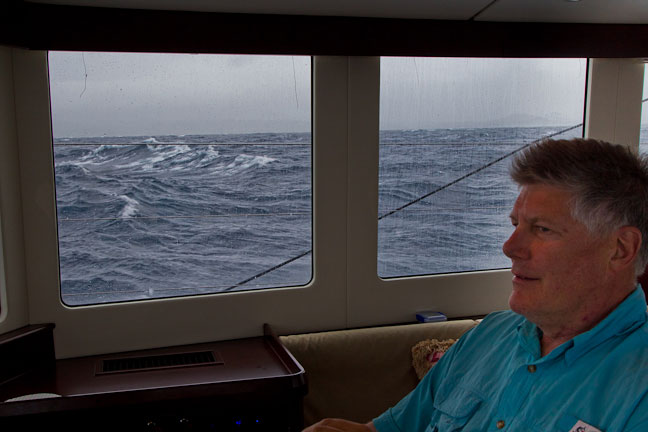
An owner happy to finally have something nasty in which to play.
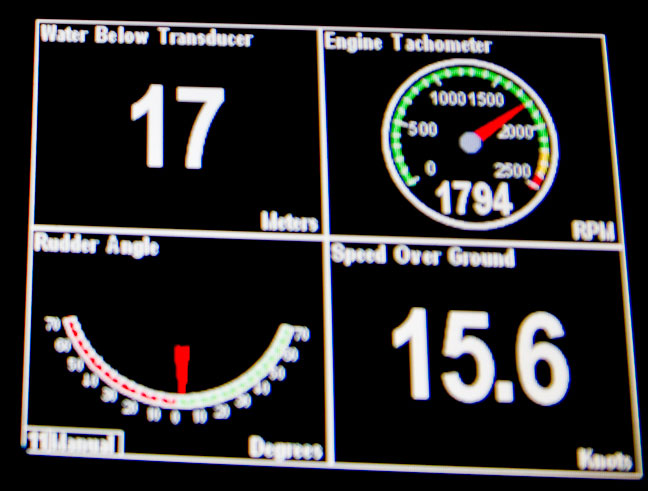
Coming into the harbor, running square best surfing speed was 15.6 knots on the GPS.
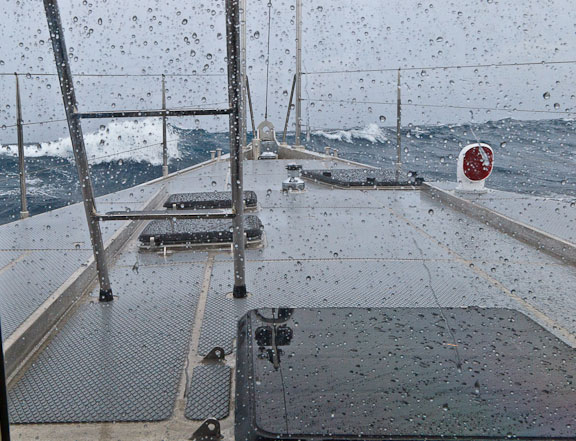
Next is a sequence shot over a second (the Canon EOS 1 Mk 4 shoots at ten frames/second). This is about an eight foot/2.4m wave. Watch the change in pitch as the wave passes by the bow.
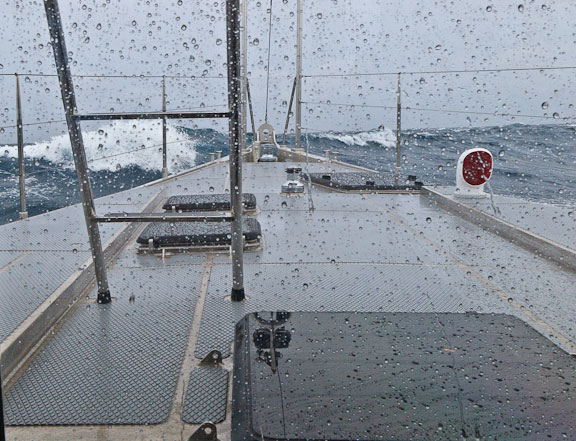
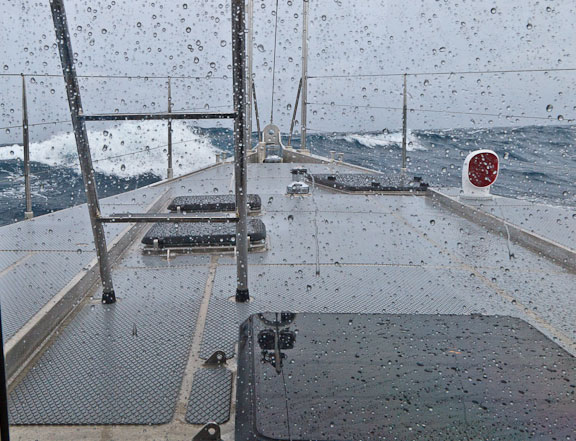

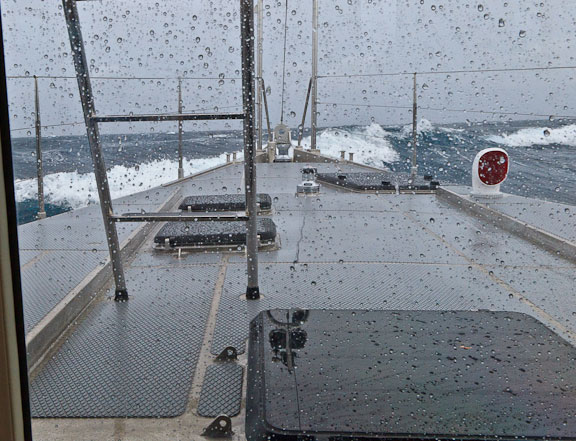
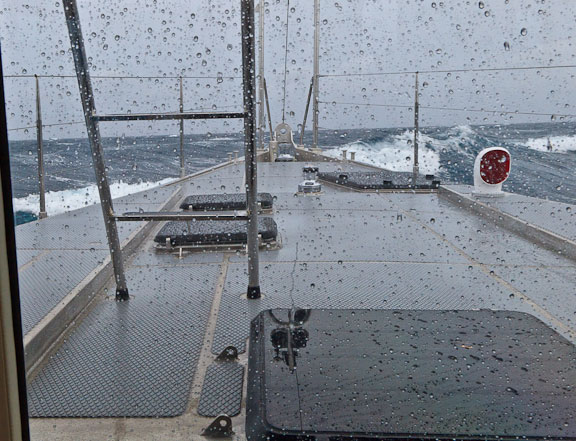
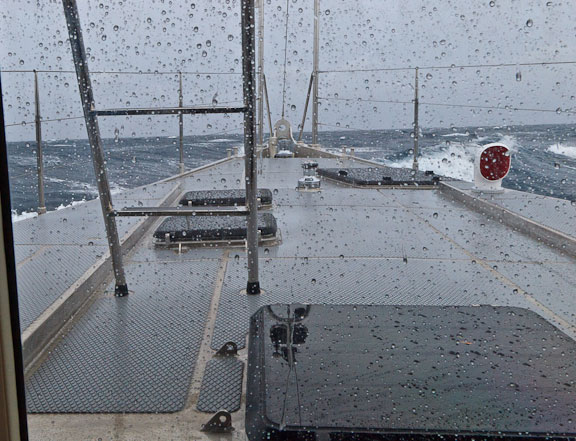
Of course not all headseas pass so smoothly, but in the open ocean with a little more space between crests, this is often the norm.
For a short video taken by Pete Rossin during this sea trial click here.
We are hopeful of more adverse weather later in the week when we go out again.

March 21st, 2011 at 8:11 pm
Hi Steve,
I bet you’re glad to be at sea again.
You noted that you tested the boat without stabilizers. I’m wondering what happens when you have a failure.
Do the fins centre themselves automatically? Is there a means to manually centre them?
Cheers,
David
March 22nd, 2011 at 2:04 am
Hi David:
To date we have not had a loss of hydraulic power required to center and pin the fins. I doubt you could do this manually at sea. Which is why we overspec these systems to maintain maximum reliability.
March 21st, 2011 at 11:03 pm
INCREDIBLE. I’m in awe. Looks like a blast!
March 21st, 2011 at 11:55 pm
Steve excuse my wording!
Make that IF you have a failure…
David
March 22nd, 2011 at 3:51 am
Steve, those miniscule changes in pitch while running are hugely impressive. This must be the most copmfortable way to cross an ocean I can imagine, except in a 747!
March 23rd, 2011 at 9:41 pm
Steve, it is amazing to see that 2.4m wave passing under (or should I say “around”?) the hull, and the fairlead remain zeroed at the horizon line !!! Was she fully loaded during the test? Also, that made me wonder … do the stabilizers have any effect on pitch at all?
Rgds
Alex
March 24th, 2011 at 5:01 am
Hi Alex:
Iron Lady is at a little over half load in the video. We will be out Friday again, with another strong wind forecast, this this time at full load. Our stabilizers are oriented for maximum transverse effectiveness and as such have little if any affect on pitching
March 27th, 2011 at 10:05 am
Hi,
Thanks for sharing.
What an incredible experience.
Good luck and keep posting info.
Glenn Rengers
Salon Vivace
March 30th, 2011 at 9:56 am
Steve
I assume when you indicate the boat was operated without stabilizers, you mean the fins are locked centered. Would not the FPB 64 in beam seas without fixed fins have a somewhat more active motion?
Bill.
March 30th, 2011 at 10:12 am
Hi Bill:
We tested the boat with fins centered by their hydraulics, but they were not locked with the locking pins. We also do this periodically with Wind Horse to check motion. With the boat at speed, i.e normal cruise of 9.5/10 knots, there was roll without the stabilizers, when compared to the motion with the stabilizers working, but not so much as to induce us to turn around. The biggest change, however, is the noise from stores rattling around in the galley. Normally we hear nothing, and make no provisions to keep things from moving. But when those bottles start rolling back and forth you know the stabs are off! Of course, the lockers can be packed to eliminate movement.
The big question for us is could we complete a long passage that had just started, if stabilizers were lost? Our feeling is that once the locker noise is dealt with we would continue. Course might be adjusted to reduce rolling, we’d probably be using our seat belts, and the crew would welcome a calm anchorage at the end, but in most cases the passage would not be any worse than some we have experienced under sail.
Lets hope this remains a hypothetical question!